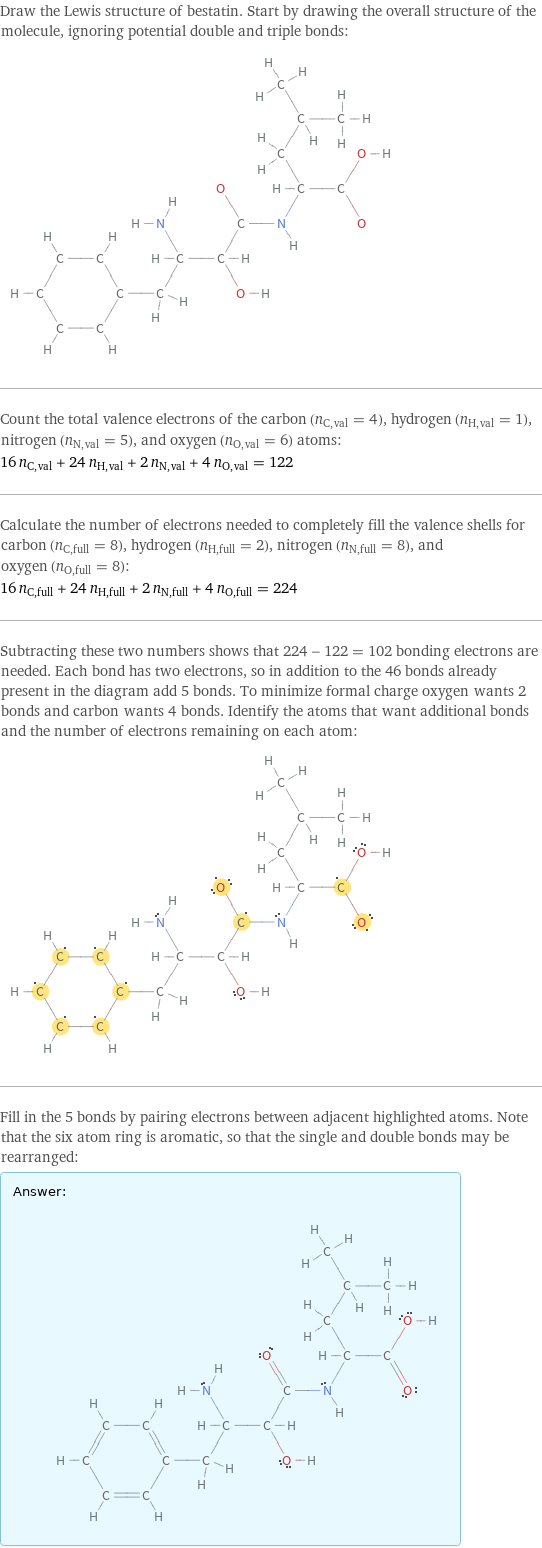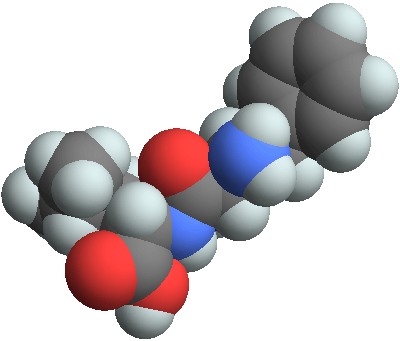Input interpretation

bestatin
Chemical names and formulas
![formula | (CH_3)_2CHCH_2CH[NHCOCH(OH)CH(NH_2)CH_2C_6H_5]CO_2H Hill formula | C_16H_24N_2O_4 name | bestatin IUPAC name | (2S)-2-[[(2S, 3R)-3-amino-2-hydroxy-1-oxo-4-phenylbutyl]amino]-4-methylpentanoic acid alternate names | (2S)-2-[[(2S, 3R)-3-amino-2-hydroxy-4-phenyl-butanoyl]amino]-4-methyl-pentanoic acid | (2S)-2-[[(2S, 3R)-3-amino-2-hydroxy-4-phenylbutanoyl]amino]-4-methylpentanoic acid | (2S)-2-[[(2S, 3R)-3-amino-2-hydroxy-4-phenyl-butanoyl]amino]-4-methyl-valeric acid | ([2S, 3 R]-3-amino-2-hydroxy-4-phenylbutanoyl)-L-leucine | ubenimex mass fractions | C (carbon) 62.3% | H (hydrogen) 7.84% | N (nitrogen) 9.08% | O (oxygen) 20.8%](../image_source/0e3503e733244c0264d27f17740a81d4.png)
formula | (CH_3)_2CHCH_2CH[NHCOCH(OH)CH(NH_2)CH_2C_6H_5]CO_2H Hill formula | C_16H_24N_2O_4 name | bestatin IUPAC name | (2S)-2-[[(2S, 3R)-3-amino-2-hydroxy-1-oxo-4-phenylbutyl]amino]-4-methylpentanoic acid alternate names | (2S)-2-[[(2S, 3R)-3-amino-2-hydroxy-4-phenyl-butanoyl]amino]-4-methyl-pentanoic acid | (2S)-2-[[(2S, 3R)-3-amino-2-hydroxy-4-phenylbutanoyl]amino]-4-methylpentanoic acid | (2S)-2-[[(2S, 3R)-3-amino-2-hydroxy-4-phenyl-butanoyl]amino]-4-methyl-valeric acid | ([2S, 3 R]-3-amino-2-hydroxy-4-phenylbutanoyl)-L-leucine | ubenimex mass fractions | C (carbon) 62.3% | H (hydrogen) 7.84% | N (nitrogen) 9.08% | O (oxygen) 20.8%
Lewis structure

Draw the Lewis structure of bestatin. Start by drawing the overall structure of the molecule, ignoring potential double and triple bonds: Count the total valence electrons of the carbon (n_C, val = 4), hydrogen (n_H, val = 1), nitrogen (n_N, val = 5), and oxygen (n_O, val = 6) atoms: 16 n_C, val + 24 n_H, val + 2 n_N, val + 4 n_O, val = 122 Calculate the number of electrons needed to completely fill the valence shells for carbon (n_C, full = 8), hydrogen (n_H, full = 2), nitrogen (n_N, full = 8), and oxygen (n_O, full = 8): 16 n_C, full + 24 n_H, full + 2 n_N, full + 4 n_O, full = 224 Subtracting these two numbers shows that 224 - 122 = 102 bonding electrons are needed. Each bond has two electrons, so in addition to the 46 bonds already present in the diagram add 5 bonds. To minimize formal charge oxygen wants 2 bonds and carbon wants 4 bonds. Identify the atoms that want additional bonds and the number of electrons remaining on each atom: Fill in the 5 bonds by pairing electrons between adjacent highlighted atoms. Note that the six atom ring is aromatic, so that the single and double bonds may be rearranged: Answer: | |
3D structure

3D structure
Basic properties

molar mass | 308.38 g/mol phase | solid (at STP) melting point | 245 °C solubility in water | soluble
Units

Hydrophobicity and permeability properties

predicted LogP hydrophobicity | -1.2 predicted LogS | -2.38
Basic drug properties

approval status | experimental | small molecule drug categories | immunologic adjuvant | anti-bacterial agent | anti-hiv agent | antineoplastic antibiotic | immunologic factor | protease inhibitor
Solid properties (at STP)

vapor pressure | 2×10^-15 mmHg (at 25 °C)
Units

Thermodynamic properties

molar heat of vaporization | 94.5 kJ/mol specific heat of vaporization | 0.306 kJ/g (at STP)
Chemical identifiers

CAS number | 58970-76-6 PubChem CID number | 72172 PubChem SID number | 24871835 SMILES identifier | CC(C)CC(C(=O)O)NC(=O)C(C(CC1=CC=CC=C1)N)O InChI identifier | InChI=1/C16H24N2O4/c1-10(2)8-13(16(21)22)18-15(20)14(19)12(17)9-11-6-4-3-5-7-11/h3-7, 10, 12-14, 19H, 8-9, 17H2, 1-2H3, (H, 18, 20)(H, 21, 22)/t12-, 13+, 14+/m1/s1/f/h18, 21H InChI key | VGGGPCQERPFHOB-VUEOKQGPCG RTECS number | OH2915000 MDL number | MFCD00083262
NFPA label

NFPA label

NFPA health rating | 1 NFPA fire rating | 0 NFPA reactivity rating | 0
Safety properties

flash point | 320 °C
Toxicity properties

RTECS classes | drug | reproductive effector | natural product